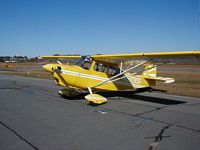 Last time I mentioned that there were two options when landing a taildragger; 3 point (full stall) landings and wheel landings. I got a taste of 3 pointers last week, and while not perfected I'm getting comfortable with them.
Last time I mentioned that there were two options when landing a taildragger; 3 point (full stall) landings and wheel landings. I got a taste of 3 pointers last week, and while not perfected I'm getting comfortable with them.Wheel landings are a bit different. My preparation for this flight included spending some time on the internet:
In a wheel landing, the airplane is flown onto the runway under power, instead of stalling it on without power, and the two mainwheels touch down first. Once that's done, power is taken out while the airplane is held down on the runway. This is done by keeping the wings at a very low, or perfectly flat, angle-of-attack (AOA) in order to not develop lift: the tail of the airplane is kept off the runway to flatten the AOA until speed bleeds off below that needed for flight.
I also listened to two good Podcasts from Aero-news.net. Part One stressed the differences in taildraggers due to aerodynamic forces and discussed the work needed for a tailwheel endorsement. Part Two talked about landings.Another good source I found stated:
The key difference between the three-point landing and the wheel landing is sink rate. Successful wheel landings require minimum sink rate. If the airplane at all settles, falls, or sinks toward the runway in the last few feet, a wheel landing will be difficult or impossible. And if the pilot flinches and applies back elevator as the main wheels touch down, the airplane will rebound into the air. At this point, the pilot needs to react quickly and efficiently--either convert the landing to a three-pointer or add power and execute a go-around. The wheel landing occurs at a higher ground speed than a three-point landing. Consequently, wheel landings tend to use up more of the available runway. It's also easier to instigate a pilot-induced-oscillation (PIO) during a wheel landing.
The weather was just beautiful. Excellent visibility, with small little puffy white clouds meant it would be a good day to fly.
Objectives of this flight; LandingsI got to the airport a little early, in time to see another student doing some T&Gs in the Decathlon. I sat on the picnic bench enjoying the weather and watching the show. When they were done the other instructor recommended to refuel with about 5 gallons on each side. I did the preflight and checked to be sure the fuel caps were on tight. My instructor arrived and we discussed going to Cartersville, but opted for home field. The winds were light and variable, the runway changed from 9 to 27 when I called for ATIS. The run up and takeoff went well.
The rest of the flight was spent driving around the pattern, giving me the experience and sight picture to fly the airplane into the landing. One was particularly good, with mains squeaking as the touched, but I was too slow to pin the tail down. (It went from a '10' to a '5' real quick.)
I never really got the picture with wheel landings. My approach was good, speed control good, but when I got into the flare I tended to push the nose down BEFORE the mains were on the ground. Not good.
So again, I have the concepts...Ideas about what I need to do, but haven't developed the techniques yet to execute the maneuver. Other airplanes allow you to 'pad' your speed just a bit. 5 Knots is not critical in them, but an additional 5 knots in a taildragger is going to cause a 'jounce' every time. It is a matter of precision. As the instructor said; "after a day like this, you can't wait to come back for more." Its hard work, but it puts a smile on my face just thinking about it. I can hardly wait until next week.
8KCAB
Time = 1.9

5 comments:
Really enjoying these taildragger posts - I am thinking of getting that endorsement myself!
the wheel landing are totally different, that why i like it a lot
the hardest part is trying to push the stick ahead or realeasing yhe preasure off
I'm sure you will do just fine once you try it out!
Scary!
Post a Comment